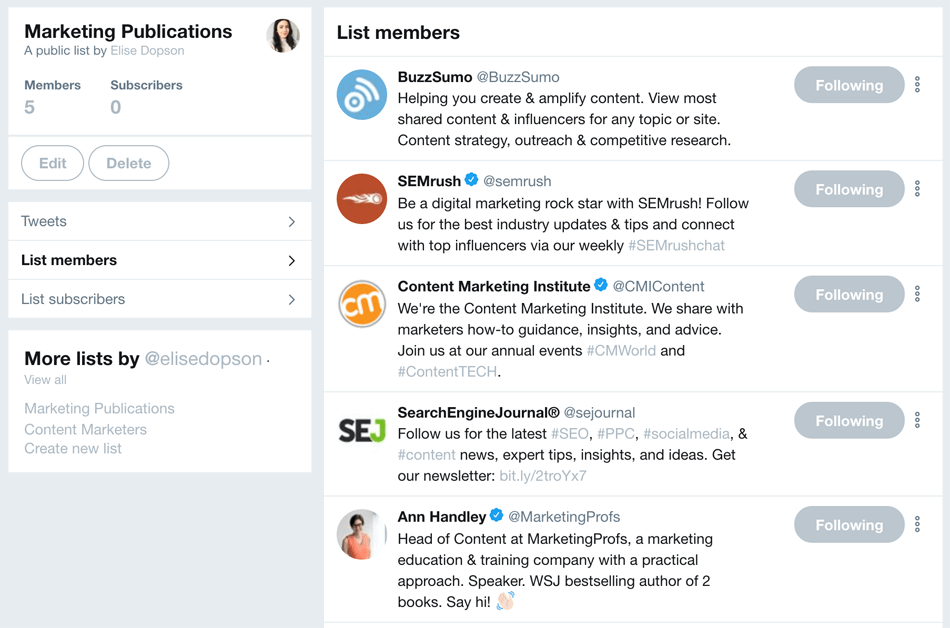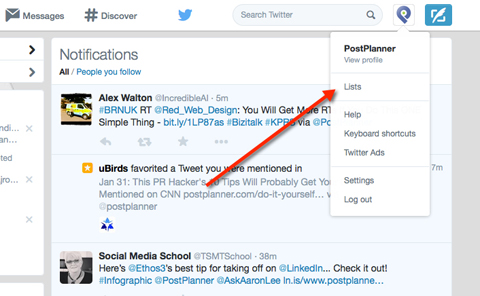BackTweets enables you to search through an archive of old tweets and find tweets that link back to your site. A Twitter List dedicated to social media industry news puts you at the forefront of platform updates, real-time content trends, C-suite interviews, and higher-level events happening in the social media landscape. Start with tech reporters, influencers, and publications who are reporting on everything social and technology-focused.
- Twitter Lists Search
- Twitter Lists Private
- Twitter Lists Private
- Twitter Lists Explained
- Twitter Lists Disappeared
A Twitter List is essentially a separate Twitter feed made up only of accounts you’ve selected. If you use Twitter for work, they can also be a useful way to separate colleagues and personal. These only display on Twitter for a limited time, after specific hashtags. While most emojis can be used in Twitter names, any emoji which resembles the verified checkmark is not permitted. See the list of emojis not permitted in Twitter names or bios. New in 2021: glossy Twemoji Stickers are now showing in Fleets. This is a list of notable Twitter services and applications. Twitter's ecosystem of applications and clients crossed one million registered applications in 2011, up from 150,000 apps in 2010. These Twitter apps were built by more than 750,000 developers around the world. A new app is registered every 1.5 seconds, according to Twitter.
If you're using Twitter but you're not using Twitter lists, oh my god, you're missing out.
A Twitter list is simply a curated group of Twitter users that allows you to efficiently organize your users in various groups and to better manage your tweets. You can subscribe to a list created by another user, or, preferably, you can create your own. By creating your own list, you can easily follow the tweets of specific groups of users separate from the ones that follow you.
A common misconception about Twitter lists is that they can be used to send tweets to multiple members of the group, when in fact they provide an efficient means of reading tweets from the list's members.
#1: Staff Directory List
You can locate all your employees on Twitter, and gather them into a single 'staff directory.' Doing this will incentivize any staff members not on Twitter to open an account, since the platform can provide a convenient way to share work-related updates and live feeds. A staff directory list also allows users outside your organization to better understand the culture behind your brand.
#2: Event Organization and Management
When it comes to events, Twitter Lists allow participants as well as those unable to attend a means of staying updated. Using a hashtag related to the event allows anyone interested to contribute to the topic at hand, and also provides an opportunity for people to keep in touch after the event. If it's too onerous to create a list of all your event's attendees, you can simply
#3: Competitors List
Creating a list comprised of your competitors' Twitter accounts is a smart business move: it keeps you up to date with any new products or changes in management, and gives you an opportunity to observe what they share on social media and the manner in which they engage with their customer base. A list of your competitors, of course, should be kept private.
#4: Extraordinary Customers
In any line of business, a customer is of immense value and should be treated as such. Twitter Lists allow you to show your gratitude to them for their loyalty. Every time you add an individual to a list, they receive a notification, and this is a great way to show your appreciation to a highly valued customer. A list of exceptional customers is basically a 'recognize and reward' list that will come in handy while organizing community-oriented campaigns in which you'd like to engage some of your most valued customers.
#5: Users who Retweet You
User who often retweet you likely share similar opinions and/or are avid fans of your brand. Just as you have a list of your favorite customers, people who frequently retweet you warrant their own list. Name the list something more original than 'Retweeters.' Try to think of something that indicates the value they offer as a veritable marketing army for your posts. Similarly, share from their posts what you see as potentially useful for your brand, creating a win-win situation and incentivizing them to share more of your posts.
#6: Your Favorite Conversationalists
Your favorite Twitter users typically respond to your tweets while also adding their thoughts and opinions to the discussion. Chatting about engaging topics is a priceless way of getting diverse ideas on issues of interest. Creating a list of these users keeps you surrounded with people who can offer valuable insight and intriguing ideas that could help take your business to the next level.
#7: Industry Players
This list includes Twitter users who work in your specific field, and not just the ones with whom you compete for customers. This list is essential for keeping up to date with a dynamic industry and its changing trends.
Twitter Lists Search
#8: Prospects
Interested in striking up conversations with companies you'd like to work with? Use a premium social media management tool like SocialBro to search all of Twitter to find people who work at companies you're interested in, then add them to a Prospects list. Of course, name it something different--or keep it private.
#9: Close Friends and Family
Twitter is a social networking site, and basic networking begins with close friends and family. With a list consisting exclusively of your personal acquaintances, you can easily stay in touch.
One small caveat: people who don't employ lists are using too few, true, but it's also possible to create too many. If you do happen to create many lists, you'll notice that one to four of them you use often, and the rest will get used hardly ever, or only very infrequently.
Go ahead and use your account to its fullest by creating the lists that will be most useful to you and your brand.
What is a Twitter list? And do you need one? Let’s take a brief look at what they are and then how to create them for your social media agency.

Are you using Twitter lists? If not, you are missing a great opportunity to connect with your ideal audience, build relationships with influencers, curate content, establish you as an authority, and more.
Sound good? Then let’s get started!
Basics of Twitter Lists
Twitter lists are a way to categorize accounts, so you can find them more easily later.
When you only use your general feed on Twitter, you are subject to the whims of the Twitter algorithm to show you what it wants. Twitter lists put you in the driver seat.
As your account grows and gets bigger, the value of lists becomes even higher. You will get the best results if you start early in building your lists and make keeping them up to date a regular part of your social media maintenance.

How to Make Your First List on Twitter
To get started, you need to be logged into your Twitter account. Remember that if you manage multiple accounts, you will need to make lists on each account that you manage. You can also follow a list in one account from another account, but we will get into that more later.
Step 1. Click on the icon to “Create new list”
If you already have Twitter lists created, instead click on the individual list to edit the items as needed. You can follow the same process for editing the list as for starting one.
Step 2. Customize with an image if you can
This is not required but will add personality to your list. It is more important on a public list.
For example, I created a list, so members of a Facebook group I am a part of could also follow each other on Twitter easily. I used the image from the Facebook group, so it would be recognizable by the members. The dimensions will be similar to those for a Twitter header image for your account.

Step 3. Create a name and description for your list
Your name is limited to only 25 characters, and your description to 100 characters. You will need to keep it short while maintaining clarity.
Twitter Lists Private
If it is a private list, you can use this name and description to help you keep track of your goal for the list.
If it is a public list, then it is important that anyone looking at the list can easily understand what it is about.
Don’t hesitate to use hashtags if it is appropriate to communicate intent in short-form.
Twitter Lists: Private vs. Public
As was mentioned, one of the options to decide when you are creating your Twitter list is whether to make it public or private.
If the list is private, only you (and anyone on your team who has full access to the account) will be able to see any of the details of the list. This includes the list name, picture, and who is on the list.
You should make a Twitter list private if it involves:
- Internal sales and marketing processes
- Competitive analysis
- A list in progress that you want to release when it is completed
- Information that is for any other internal company use only
You should make a Twitter list public if:
- Goals for the list include building your credibility as an authority
- You want to use Twitter lists to highlight influencers or partners publicly
- The list is created to provide a resource to external parties
Twitter Lists Private
How to Set Up Your Initial Twitter Lists
Building your lists does not have to be overwhelming. Approach it systematically and you can create your core Twitter lists in no time. (Well, OK, not in NO time … but how about 1-3 hours?)
Step 1. Brainstorm the lists you need (15 minutes)
Come up with all the different ways you can use Twitter lists in your business.
When you are in the brainstorming phase, generate more ideas than you really need to help you find the best ones. (You’ll have more to choose from!)
I recommend you come up with at least 20 different potential lists. Is your team working together? Set a timer for 5 minutes. Have each person write down as many ideas as they can. Then take 5 minutes to share your lists and another 5 minutes to add new ideas that the shared brainstorm generates.
Step 2. Create your initial lists on Twitter (10-20 minutes)
Narrow your master list down to 5-7 lists that will have the biggest impact on your overall social media goals. Create the lists (whether Twitter public lists or Twitter private lists) using the above steps. Make sure to mark your private lists private!
Step 3. Gather the details for each list (30-45 minutes)
Twitter Lists Explained
Ideally, you will be able to use lists of people that you have created in other marketing systems. You can put them on a spreadsheet, or print out a list. Whatever is easiest for you will work for this step.
Personally, I find it helpful to have a physical piece of paper in front of me that I can write on.
Some examples of existing databases to use:
- Your current clients (from your CRM, billing software, or another system)
- Potential clients that you are doing outreach to
- Influencers you are actively targeting
- Competitors
If you use Agorapulse, you can also use the fans and followers function to find your most engaged connections on social media. These are also good potentials for various lists.
In Agorapulse, you can view all your most engaged users.
Interact with these people to build stronger relationships. You can write notes on each user and see their company information. You can also click the Twitter logo to go directly to their account to easily add them to a list.
Step 3. Find them on Twitter and add them to Your Lists (1-2 hours)
Twitter Lists Disappeared
Don’t get distracted! It is easy to get sucked into trending hashtags on Twitter or replying to your inbox while you are there. Remember that you have a job to do.
Some strategies that can help keep you on track are:
- Divide and conquer. Is there another member of your team that can help you with this process?
- Have a friendly competition. See who can finish their lists first.
- Set a timer. Put a limit on how long you have to get this done.
You might want to follow or unfollow these accounts at the same time you are adding them to the lists.
How to Maintain Your Twitter Lists
After putting in the effort to create your Twitter lists, make a plan for managing Twitter lists.
Like the rest of your social media, they will only continue to work for you if you work with them.
You will want to think about how Twitter lists interact with both your long-term and short-term strategy.
- Add reviewing your lists to your daily and/or weekly social media to-do list.
- Review your Twitter lists as a part of your regular audit process.
- Categorize new people when you follow them or when they follow you.
You can also use lists in combination with user labels in Agorapulse to make this a streamlined part of your daily management.
Finally, don’t be afraid to delete a list when it is no longer meeting your purposes.
* * *
Want more helpful, actionable content like this? Subscribe to the Agorapulse newsletter, and get the most recent blog posts and news about the social media channels you use most.
